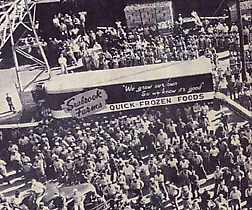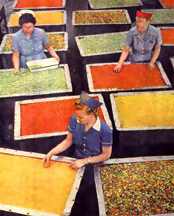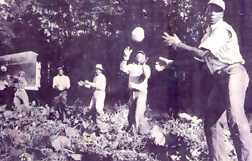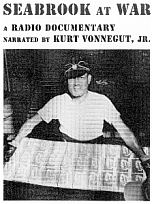
Seabrook at War: A Radio Documentary. Narrated by Kurt Vonnegut, Jr. Written and Produced by Marty Goldensohn and David Steven Cohen. A co-production of WWFM/WWNJ, Trenton and the New Jersey Historical Commission, Department of State, 1995.
 | Seabrook workers at the unloading dock.
From a Life magazine photo, Jan. 3, 1955. |
In January 1944, Seabrook Farms began recruiting interned Japanese Americans to southern New Jersey as replacements for its dwindling wartime labor force.
Featured in Readers Digest,
the name Seabrook conjured images of mechanized farming, wartime spirit, and harmonious labor and race relations.
Within a year, nearly 1,000 workers had relocated to Seabrook from internment camps throughout
the South and Southwest, and the total number of Japanese Americans resettled there reached close to 3,000 thousand. In addition, other recruits came from as far away as Mexico, South America, and the Caribbean. Five decades later, former Seabrook families gathered to remember their experiences, sharing stories that both confirmed and challenged
"Labor, Loyalty and Loss."
From Seabrook at War. |
|
28.8
| 56k
|
this agricultural community’s wartime image. Seabrook At War captures these experiences in an hour-long oral history of what narrator Kurt Vonnegut Jr. calls a story of "labor, loyalty and loss."
The oral history begins by explaining the history of this southern New Jersey farming community. Charles F. Seabrook, known to his family as "C.F." and to the rest of the business world as "the Henry Ford of agriculture," first established Seabrook Farms as a model of mechanized farming in 1911.
 |
Workers sort vegetables at
Seabrook. From a Life magazine
photo, Jan. 3, 1955.
|
As an engineer, he focused his energies on building power plants and irrigation systems.
By combining new technologies with traditional truck farming, Seabrook Farms carved out a niche as a producer and packager of frozen vegetables including well-known brands such as Birdseye.
The company's moment of real expansion came with World War II—by supplying the military with food. Seabrook Farms had long struggled with
labor shortages and difficulties, and the wartime labor market heightened their need for a new labor source.
Jack Seabrook, C.F.'s son, was in charge of labor issues, and he turned
Jack Seabrook seeks Japanese-American labor.
From Seabrook at War. | |
28.8
| 56k | to the War Relocation Authority to request the release of interned Japanese Americans to come to work on the company farm.
Decades later, Jack Seabrook serves as a powerful voice throughout this oral history. He recalls both the constant internal family struggles and the negotiations between the Seabrooks and the Japanese Americans. His reflections suggest the existence of a benevolent paternalism whereby the Seabrooks safeguarded their workers from any local harassment as "enemy aliens."
His mostly positive memories seem to be shared by many of the workers themselves. Many
Jack Seabrook on safeguarding
workers. From Seabrook at War. |
|
28.8
| 56k
|
transplanted families in fact remained at Seabrook after the war where the company continued to grow and prosper. By 1955, Life magazine heralded Seabrook as the largest vegetable factory in the world.
The Murona Family.
From Peru, to Texas, to Seabrook.
From Seabrook at War. |
|
28.8 | 56k
|
On the whole though, the agricultural workers tell a different story. They recount a work routine of long hours, poor pay, and pitiful living conditions. And above all, they describe the complete disruption of their lives. Ginzo Murona, for example, was living in Peru when he was removed from his family without notification and placed in a Texas internment camp. In the many interviews, the parents who moved to Seabrook and did most of the labor convey their stories without bitterness; in contrast, their children express strong feelings of resentment. It is they who most sharply tell a tale of injustice and the denial of civil liberties.
 |
Seabrook farmworkers harvest crops.
From a Life magazine photo, Jan. 3, 1955.
|
The story of this one wartime community sheds light on several overlapping narratives. The oral testimony of the Seabrooks and their workers effectively conveys the
complicated nature of the American home front.
The relocation experiences of Japanese Americans reflect only partially the tremendous growth of governmental authority during World War II. In addition, the internment and treatment of Issei and Nisei citizens also raise complex questions about race and racialized stereotyping. Finally, the experience at Seabrook provides a window into the history of agricultural labor relations and commercial, scientific farming. The history of Seabrook captures each of these themes nicely.
The aftermath of war:
Seabrook in the l950s.
From Seabrook at War. |
|
28.8
| 56k
|
Overall, this one-hour oral history would work well as an effective teaching tool. Students can easily grasp all the major themes, and the various voices evoke vivid images.
 |
| A Seabrook Worker. Cover from Seabrook at War.
|
Though some of the workers themselves depict the harsh conditions they faced, the interviewers might have included more voices of discontent,
including perhaps some contemporary anti-Japanese radio clips. But in this way, the story of Seabrook Farms presented here serves as a useful starting point for an undergraduate research project on the home front during World War II. Because Seabrook ultimately employed 2,500 of the 120,000 interned Japanese-Americans, it received wide coverage in local and national newspapers and magazines. The internment itself has of course gained much scholarly attention by legal, political, and social historians, and Seabrook is the subject of at least one article. Thus, Seabrook at War would enhance many 20th-century American history courses.
Meg Jacobs
Massachusetts Institute of Technology
~ End ~
Audio Review of Seabrook at War
Copyright
© 1999 by The Journal for MultiMedia History
With the permission of David Steven Cohen and the New Jersey Historical Commission, The Journal for MultiMedia History presents Seabrook At War: A Radio Documentary in its entirety. To facilitate listening, we have divided the original one-hour program into two parts.
|
Seabrook At War: A Radio Documentary. Part I. |
|
28.8
| 56k
|
|
Seabrook At War: A Radio Documentary. Part II. |
|
28.8
| 56k
|
|
Comments
| JMMH
Contents
|



